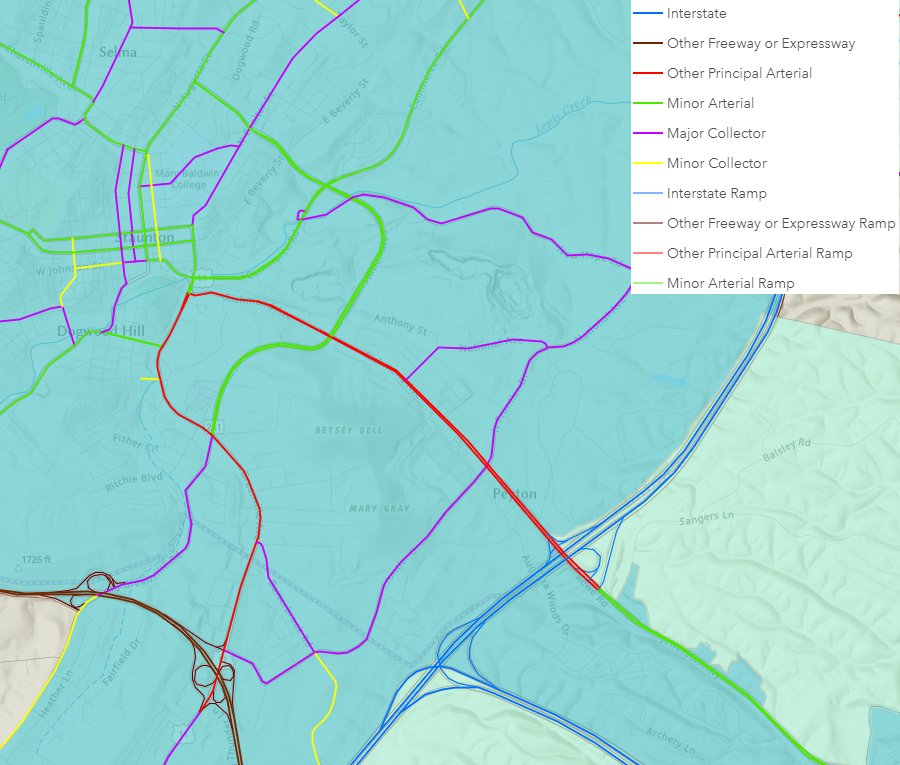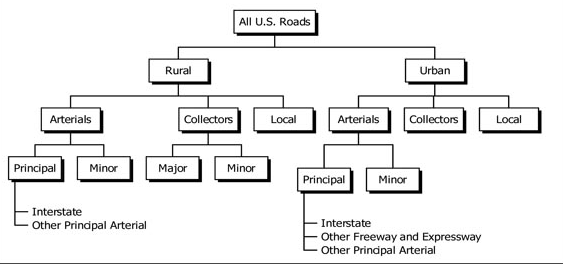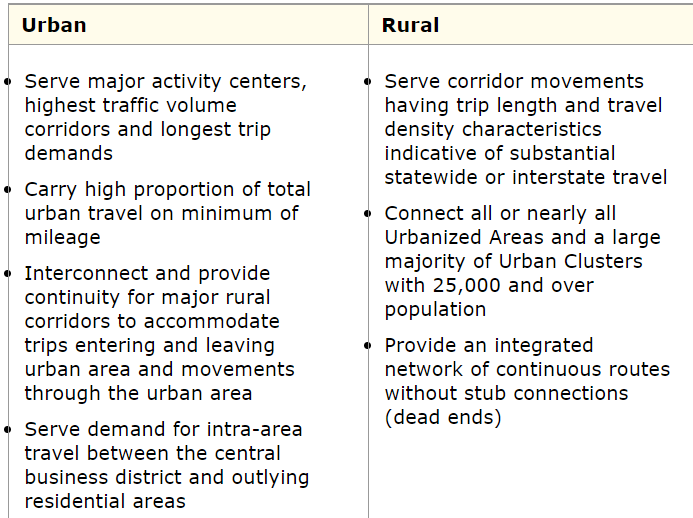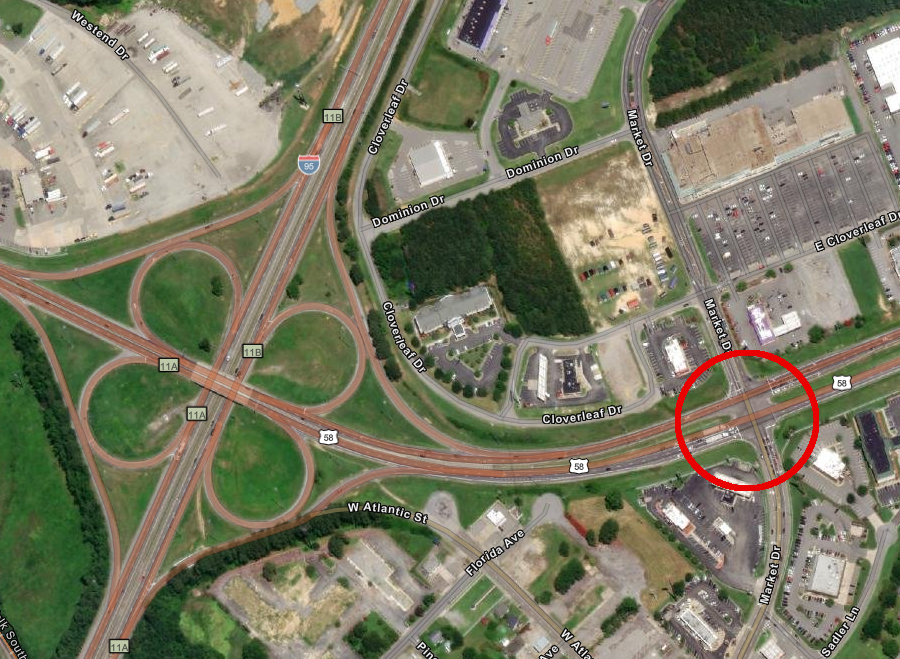
functional classification of roads around Staunton
Source: Virginia Department of Transportation (VDOT), VDOT 2014 Approved Functional Classification Web Map

functional classification of roads around Staunton
Source: Virginia Department of Transportation (VDOT), VDOT 2014 Approved Functional Classification Web Map
Road names chosen by developers and local governments have little meaning to transportation engineers and maintenance planners. They categorize roads by functional classification in order to identify a common capacity to handle vehicles and to establish common design standards, such as the minimum distance between intersections.
Classification of roads by function began with the Federal Aid Act of 1921, though different states initially used inconsistent classifications of the types of roads in the network. A common standard for all states was established after passage of the Federal Aid Highway Act of 1973. The classifications are updated as needed in consultation with the American Association of State Highway Transportation Officials (AASHTO).
Engineers at the Virginia Department of Transportation traditionally rely upon AASHTO's "Green Book," technically the A Policy on Geometric Design of Highways and Streets when determining the width of travel lanes and speed limits on different types of highways. In addition, road design now considers the location of the roads to establish a context-sensitive design, with guidance from AASHTO's A Guide for Achieving Flexibility in Highway Design and Guidelines for Geometric Design of Low-Volume Rows.
The standard width of travel lanes for Arterial roads in rural areas is 12 feet wide, and the standard width for Collector roads is 11 feet wide. Those widths could be reduced as part of context sensitive design in rural towns, suburban areas, urban areas, and urban core areas.1
As described by the Federal Highway Administration (FHWA):2
Widespread availability of the automobile in the early 1900's led to demands to expand the paved road network. In Virginia, new road construction was limited by the "pay as you go" approach implemented by Harry F. Byrd. He blocked efforts for the state government to borrow money to pave roads, in part based upon Virginia's overly-ambitious transportation funding mistakes in the first half of the 1800's. After the Civil War, the state struggled for decades to repay the debt incurred by selling bonds to finance money-losing turnpikes, canals, and railroads.
In the 1950's, the Federal government committed to financing the Interstate Highway System. Those access-controlled highways served only particular corridors, and did not cross many jurisdictions in Virginia. Cities and towns without an interstate highway recognized that they would need a high-quality transportation connection to the nearest interstate in order to attract new industries.
That led to creation of the arterial road system in Virginia. In 1962, Gov. Albertis S. Harrison Jr. appointed the Virginia Highway Study Commission led by Sen. William F. Stone to examine the highway system. A year later, in time for the 1964 General Assembly, the commission provided its recommendations. The report included:3
The arterial road network was designed to provide four lane, divided highways with links to all interstate highways, allowing trucks and cars to go 55 miles per hour across the state. The combined arterial ad interstate network expanded multi-lane divided highways from 300 miles to 3,000 miles:4
Virginia classifies its over 57,000 miles of roads by function as "Arterial," "Collector," and "Local." The state also uses a different classification system, categorizing roads as being part of the Primary or Secondary system (in addition to Interstates and Frontage roads). All Arterial roads are in the Primary system and given numbers up to 599. Collector and Local roads are in the Secondary system and numbered 600 or higher.
Frontage Roads parallel major highways, especially interstates, to provide access to parcels of land. The 333 miles of frontage roads in Virginia are numbered starting at F-001, and numbers reach into four digits.
Arterial roads are further subdivided into:
- Interstate
- Other Freeways and Expressways
- Other Principal Arterial
- Minor Arterial
Collector roads are further subdivided into:
- Major Collector
- Minor Collector
Local roads also include frontage roads.
For decades, the Federal government classified roads in part based on whether they were located in urban or rural locations. As suburbs expanded, the distinction became less relevant. Separate rural/urban classifications were consolidated in 2008.5

roads are classified by their function for mobility and access, but the rural/urban distinction is no longer very significant
Source: Federal Highway Administration (FHWA), 2008 Status of the Nation's Highways, Bridges, and Transit: Conditions and Performance (Exhibit 2-3)
Roads provide "access" to land along the road, and "mobility" for vehicles to travel from origin to destination. Local roads prioritize access to adjacent parcels, with many curb cuts and driveways. Arterial roads prioritize mobility, moving traffic fast without delay for vehicles turning off the road or entering from the side.
Interstate highways are limited access roads, with no at-grade intersections and minimum distances required between interchanges. Though classifying some roads requires judgement calls to distinguish between arterial, collector, and local, it is obvious that all interstate highways are arterial roads. The judgement call to categorize a road as an Arterial vs. Collector, Major Collector vs. Minor Collector, or Collector vs. Local hinges on whether the road primarily serves to provide mobility or access.
"Other arterials" can include two-lane roads through rural areas connecting two places of higher population density. Such arterials will have direct driveway connections to the road, but their primary function is mobility rather than access.

characteristics of urban and rural arterials
Source: Federal Highway Administration (FHWA), Highway Functional Classification Concepts, Criteria and Procedures (Table 3-1)
Collector roads link Local and Arterial roads. Collectors gather traffic from smaller roads and funnel it into the Arterial network. While the standard speed for Arterial roads in rural areas may be 55 miles/hour, Collectors will often have a lower speed limit. The Virginia Department of Transportation Roadway Design Manual has different design standards for Collectors than Arterials:6
Most road mileage is classified as a Local road, with direct connections to homes and businesses. Most trips begin and end on a local road, with travel on Collector and Arterial sections between origins and destinations. The Federal government provides no funding for construction of maintenance of local roads. The Virginia Department of Transportation (VDOT), the counties of Arlington and Henrico, cities, and towns are responsible for those roads.7

both I-95 and US 58 at Emporia are principal arterials, but the interstate has only grade-separated interchanges while US 58 has at-grade intersections
Source: ESRI, ArcGIS Online